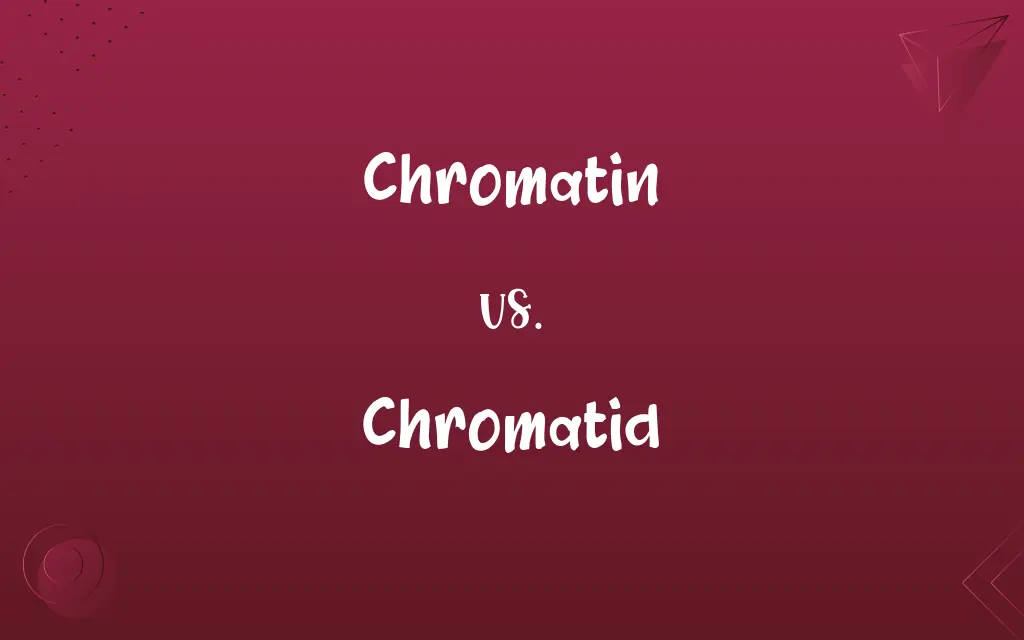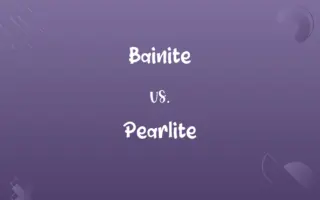Chromatin vs. Chromatid: Know the Difference

By Shumaila Saeed || Updated on December 25, 2023
Chromatin is the complex of DNA and proteins in the nucleus, while a chromatid is one half of a duplicated chromosome.

Key Differences
Chromatin is a substance within a chromosome consisting of DNA and protein. The primary function of chromatin is to compress the DNA into a compact, space-efficient form inside the cell nucleus. On the other hand, a chromatid refers to one of two identical halves of a replicated chromosome. During cell division, these chromatids separate, ensuring each new cell receives an identical set of genetic material.
Shumaila Saeed
Dec 06, 2023
In terms of structure, chromatin is found throughout the cell cycle. It exists in two forms: euchromatin, which is less condensed and actively involved in transcription, and heterochromatin, which is tightly packed and generally inactive. Chromatids, in contrast, become visible only during certain stages of cell division, particularly during mitosis and meiosis. Each chromatid is a single, long DNA molecule, a replica of its sister chromatid.
Shumaila Saeed
Dec 06, 2023
Regarding function, chromatin plays a crucial role in regulating gene expression and DNA replication. The way DNA is packaged into chromatin can affect which genes are active in a cell. Chromatids are essential for genetic segregation; during cell division, the sister chromatids are pulled apart to ensure each daughter cell receives an identical set of chromosomes.
Shumaila Saeed
Dec 06, 2023
From a genetic perspective, chromatin's state can be modified through processes like methylation and acetylation, affecting gene activity. Chromatids, once separated during cell division, become individual chromosomes in the daughter cells, carrying the genetic information forward.
Shumaila Saeed
Dec 06, 2023
Finally, the study of chromatin is critical in understanding epigenetics, as changes in chromatin structure can lead to changes in gene expression without altering the DNA sequence. The study of chromatids is vital in understanding the mechanics of chromosome behavior during cell division, which has implications in genetics and cell biology.
Shumaila Saeed
Dec 06, 2023
ADVERTISEMENT
Comparison Chart
Definition
Complex of DNA and proteins in the nucleus
One half of a duplicated chromosome
Shumaila Saeed
Dec 06, 2023
Visibility
Visible throughout the cell cycle
Visible only during cell division
Shumaila Saeed
Dec 06, 2023
Role in Cell Cycle
Involved in DNA packaging, gene expression, and replication
Essential for genetic segregation during cell division
Shumaila Saeed
Dec 06, 2023
Structural Changes
Can switch between loosely packed (euchromatin) and tightly packed (heterochromatin) forms
Remains structurally constant until separation during mitosis
Shumaila Saeed
Dec 06, 2023
Genetic Implications
Modifications affect gene activity and expression
Separation ensures equal genetic distribution to daughter cells
Shumaila Saeed
Dec 06, 2023
ADVERTISEMENT
Chromatin and Chromatid Definitions
Chromatin
Chromatin is the material that makes up a chromosome, consisting of DNA and histone proteins.
The organization of chromatin in the nucleus determines which genes are active.
Shumaila Saeed
Dec 06, 2023
Chromatid
A chromatid is one of the two identical halves of a replicated chromosome.
During mitosis, chromatids are separated into two new nuclei.
Shumaila Saeed
Dec 06, 2023
Chromatin
Chromatin is the form in which the genetic material is present in the interphase nucleus.
Specific staining techniques are used to visualize chromatin under a microscope.
Shumaila Saeed
Dec 06, 2023
Chromatid
Chromatids are the replicated forms of chromosomes visible during certain stages of cell division.
The separation of sister chromatids ensures genetic consistency in daughter cells.
Shumaila Saeed
Dec 06, 2023
Chromatin
Chromatin is a dynamic structure that controls DNA replication and gene expression.
Alterations in chromatin structure can lead to changes in gene activity.
Shumaila Saeed
Dec 06, 2023
ADVERTISEMENT
Chromatid
A chromatid is a chromosome copy that remains attached to its original until cell division.
The spindle fibers attach to chromatids during mitosis for their segregation.
Shumaila Saeed
Dec 06, 2023
Chromatin
Chromatin refers to the DNA-protein complex that forms chromosomes within the cell nucleus.
Scientists study chromatin to understand genetic regulation and inheritance.
Shumaila Saeed
Dec 06, 2023
Chromatid
Chromatids are identical strands formed by the duplication of a chromosome.
Geneticists study chromatids to understand chromosomal behavior in inheritance.
Shumaila Saeed
Dec 06, 2023
Chromatin
Chromatin is a complex of macromolecules found in cells, consisting of DNA, protein, and RNA.
Chromatin's structure changes during cell division, becoming highly condensed.
Shumaila Saeed
Dec 06, 2023
Chromatid
A chromatid consists of a single DNA molecule, representing one-half of a duplicated chromosome.
Each chromatid joins its sister at a region called the centromere.
Shumaila Saeed
Dec 06, 2023
Chromatin
A complex of nucleic acids and proteins, primarily histones, in the cell nucleus that stains readily with basic dyes and condenses to form chromosomes during cell division.
Shumaila Saeed
Oct 19, 2023
Chromatid
Either of the two daughter strands of a replicated chromosome that are joined by a single centromere and separate during cell division to become individual chromosomes.
Shumaila Saeed
Oct 19, 2023
Chromatin
(biology) A complex of DNA, RNA and proteins within the cell nucleus out of which chromosomes condense during cell division.
Shumaila Saeed
Oct 19, 2023
Chromatid
(genetics) After DNA replication, either of the two connected double-helix strands of a metaphase chromosome that separate during mitosis.
Shumaila Saeed
Oct 19, 2023
Chromatid
One of two identical strands into which a chromosome splits during mitosis.
Shumaila Saeed
Oct 19, 2023
Chromatin
The deeply staining substance of the nucleus and chromosomes of eukaryotic cells, composed of DNA and basic proteins (such as histones), the DNA of which comprises the predominant physical basis of inheritance. It was, at the beginning of the 20th century, supposed to be the same substance as was then termed idioplasm or germ plasm. In most eukaryotic cells, there is also DNA in certain plasmids, such as mitochondria, or (in plant cells) chloroplasts; but with the exception of these cytoplasmic genetic factors, the nuclear DNA of the chromatin is believed to contain all the genetic information required to code for the development of an adult organism. In the interphase nucleus the chromosomes are dispersed, but during cell division or meiosis they are condensed into the individually recognizable chromosomes. The set of chromosomes, or a photographic representation of the full set of chromosomes of a cell (often ordered for presentation) is called a karyotype.
Shumaila Saeed
Oct 19, 2023
Chromatid
One of two identical strands into which a chromosome splits during mitosis
Shumaila Saeed
Oct 19, 2023
Chromatin
The readily stainable substance of a cell nucleus consisting of DNA and RNA and various proteins; during mitotic division the chromatin condenses into chromosomes
Shumaila Saeed
Oct 19, 2023
Repeatedly Asked Queries
What is a chromatid?
A chromatid is one of the two identical halves of a replicated chromosome, visible during cell division.
Shumaila Saeed
Dec 06, 2023
Are chromatin and chromatids the same?
No, chromatin is the material chromosomes are made of, while chromatids are the replicated forms of chromosomes.
Shumaila Saeed
Dec 06, 2023
What role do chromatids play in cell division?
Chromatids ensure that each daughter cell receives an identical set of chromosomes during cell division.
Shumaila Saeed
Dec 06, 2023
Can chromatin structure change?
Yes, chromatin structure can change, affecting gene expression through epigenetic mechanisms.
Shumaila Saeed
Dec 06, 2023
What is chromatin?
Chromatin is the complex of DNA, RNA, and proteins that form chromosomes within the cell nucleus.
Shumaila Saeed
Dec 06, 2023
Does chromatin exist in all cells?
Chromatin is present in all eukaryotic cells containing a nucleus.
Shumaila Saeed
Dec 06, 2023
How does chromatin function in cells?
Chromatin organizes DNA into a compact form, regulates gene expression, and facilitates DNA replication.
Shumaila Saeed
Dec 06, 2023
Are changes in chromatin reversible?
Some changes in chromatin structure, like acetylation and methylation, can be reversible.
Shumaila Saeed
Dec 06, 2023
When are chromatids formed?
Chromatids are formed during the S phase of the cell cycle, as chromosomes are replicated.
Shumaila Saeed
Dec 06, 2023
Is chromatin visible under a microscope?
Chromatin can be observed under a microscope, especially when the DNA is condensed.
Shumaila Saeed
Dec 06, 2023
What is the significance of chromatids in genetics?
Chromatids play a critical role in genetic stability and inheritance during cell division.
Shumaila Saeed
Dec 06, 2023
How is chromatin structure important?
The structure of chromatin affects gene accessibility and expression, influencing cellular function.
Shumaila Saeed
Dec 06, 2023
What happens to chromatids during mitosis?
During mitosis, sister chromatids separate, moving to opposite poles of the cell.
Shumaila Saeed
Dec 06, 2023
Do chromatids separate in all types of cell division?
Chromatids separate during mitosis and meiosis, but not during other cellular processes.
Shumaila Saeed
Dec 06, 2023
What are histones in chromatin?
Histones are proteins around which DNA winds, forming a nucleosome in chromatin.
Shumaila Saeed
Dec 06, 2023
How does chromatin affect DNA replication?
Chromatin compaction levels influence the accessibility of DNA for replication.
Shumaila Saeed
Dec 06, 2023
Do chromatids have a specific structure?
Chromatids are linear structures, attached at the centromere, and contain a DNA double helix.
Shumaila Saeed
Dec 06, 2023
How many chromatids are in a duplicated chromosome?
A duplicated chromosome has two identical sister chromatids.
Shumaila Saeed
Dec 06, 2023
What is the difference between chromatids and chromosomes?
Chromosomes are single DNA molecules, while chromatids are identical copies of these chromosomes formed during replication.
Shumaila Saeed
Dec 06, 2023
Can chromatin be artificially modified?
Yes, chromatin can be artificially modified in labs to study gene function and regulation.
Shumaila Saeed
Dec 06, 2023
Share this page
Link for your blog / website
HTML
Link to share via messenger
About Author
Written by
Shumaila SaeedShumaila Saeed, an expert content creator with 6 years of experience, specializes in distilling complex topics into easily digestible comparisons, shining a light on the nuances that both inform and educate readers with clarity and accuracy.









































































